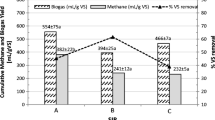Summary
In batch fermentation tests the effect of the substrate concentration on the methane fermentation process of the sewage sludge was controlled. In the range of 1.5 up to 6.5 percent of dry solids content in the raw sludge no changes could be demonstrated in the fermentation course, digestion of the organic substance, sludge gas production and in the organic compounds decomposition. The ratio of the solid phase concentration to the water content determined the ion concentration of the solution, which during the fermentation process would increase. The ion concentration affects the enzymatic activity of the bacteria and their metabolic process as well. The increase of the concentration of some ions, e.g. of ammonia-ions, above the given limit would inhibit the fermentation course. At conditions of the tests this limit would not be exceeded so that the inhibition of the fermentation could not be observed. In accordance with the composition of the mineral and organic part of the sludge particles the buffer capacity of media would result which is considered to be most significant for preserving the pH value in suitable limits for the bacteria, participating on the methane fermentation of organic substrate.
Zusammenfassung
In Schichtfermentations-Versuchen wurde der Einfluss der Subtratkonzentration auf die Methanfermentation von Klärschlamm bestimmt. Es wurde nachgewiesen, dass im Bereich von 1,5 bis 6,5% Trockensubstanz keine Änderungen im Verlaufe der Fermentation, in der Digestion organischer Stoffe, in der Faulgasproduktion und im Abbau der Kohlenstoffverbindungen auftreten. Das Konzentrationsverhältnis der festen Phase des Schlammes zu seinem Wassergehalt bestimmt aber die Ionenstärke des Milieus, die während der Fermentation erhöht wird. Die Ionenkonzentration beeinflusst die enzymatische Tätigkeit der Bakterien und dadurch auch ihre metabolischen Vorgänge. Die Erhöhung von Ionenkonzentration (z.B. Ammoniumionen) über eine gewisse Grenze inhibiert den Fermentationsverlauf. Unter den Bedingungen der angeführten Versuche, wo die Substratkonzentration die bei dem Betrieb der Faulbehälter üblichen Werte nicht überschritten hat, wurde denn auch keine Inhibition der Methanfermentation beobachtet. Die Zusammensetzung des organischen und anorganischen Anteils des Schlammes bestimmt die Pufferkapazität des Milieus, die für die Erhaltung des pH-Wertes in den für die Bakterientätigkeit geeigneten Grenzen wichtig ist.
Résumé
L'on a, dans des essais de fermentation par couches, étudié l'effet de la concentration du substrat sur le processus de fermentation des boues d'épuration au méthane. On constata que, lorsque les boues ont une teneur en matière sèche entre 1,5 et 6,5%, il ne se produit aucun changement dans la fermentation, dans la digestion des substances organiques, dans la production de gaz de digestion, ni dans la décomposition des carbures. C'est toutefois du rapport entre la phase solide des boues et leur teneur en eau que dépend la concentration du milieu en ions, concentration qui augmente au cours de la fermentation. La concentration en ions influe sur l'activité enzymatique des bactéries et, de ce fait, aussi sur leur métabolisme. L'augmentation des concentrations de certains ions (ions d'ammonium par exemple) au-delà d'une certaine limite freine le processus de fermentation. Dans les conditions qui régnaient pendant les essais en question, les concentrations du substrat ne dépassèrent pas les valeurs observées dans la pratique, de sorte qu'il ne se produisit aucune inhibition de la fermentation au méthane. La composition de la fraction organique et celle de la fraction inorganique des boues détermine la capacité tampon du milieu, capacité qui est très importante pour le maintien de la valeur pH dans les limites favorables à l'activité bactérienne.
Similar content being viewed by others
References
Edmonds, C.J.,Effect of Solids Concentration on the Anaerobic Digestion of Domestic Sewage, Thesis Iowa State Univ. of Sci. a. Techn.262 (1965).
Keefer, C.E.,The Digestion of Sewage Sludge Containing Various Concentrations of Solids, Sew. Works Journ.19, 39 (1947).
Kugelman, J.J., andMc Carty, P.L.,Calion Toxicity and Stimulation in Anaerobic Waste Treatment, Eng. Bull. Purdue Univ. Proc. 19th Ind. Waste Conf. 667 (1964).
Liebmann, H.,Zur Biologie der Methanbakterien, Ges. Ing.,71, 14, 56 (1950).
McCarty, P.L.,Anaerobic Waste Treatment Fundamentals, Pub. Works95, Sept. 107, Oct. 123, Nov. 9, Dec. 95 (1964).
Poch, M.,Biogas (Deutscher Bauernverlag, Berlin 1953).
Schulze, K.L.,Studies on Sludge Digestion and Methane Fermentation, Sew. Ind. Wastes30, 164 (1958).
Marlý, J., andFadrus, H.,Änderungen der chemischen Eigenschaften des Klärschlammes bei der Methanfermentation, Schweiz. Z. Hydrol.33, 121 (1971).
Author information
Authors and Affiliations
Rights and permissions
About this article
Cite this article
Malý, J., Fadrus, H. Effect of the substrate-concentration on the methane fermentation of sewage sludge. Schweiz. Z. Hydrologie 33, 578–591 (1971). https://doi.org/10.1007/BF02502077
Issue Date:
DOI: https://doi.org/10.1007/BF02502077




